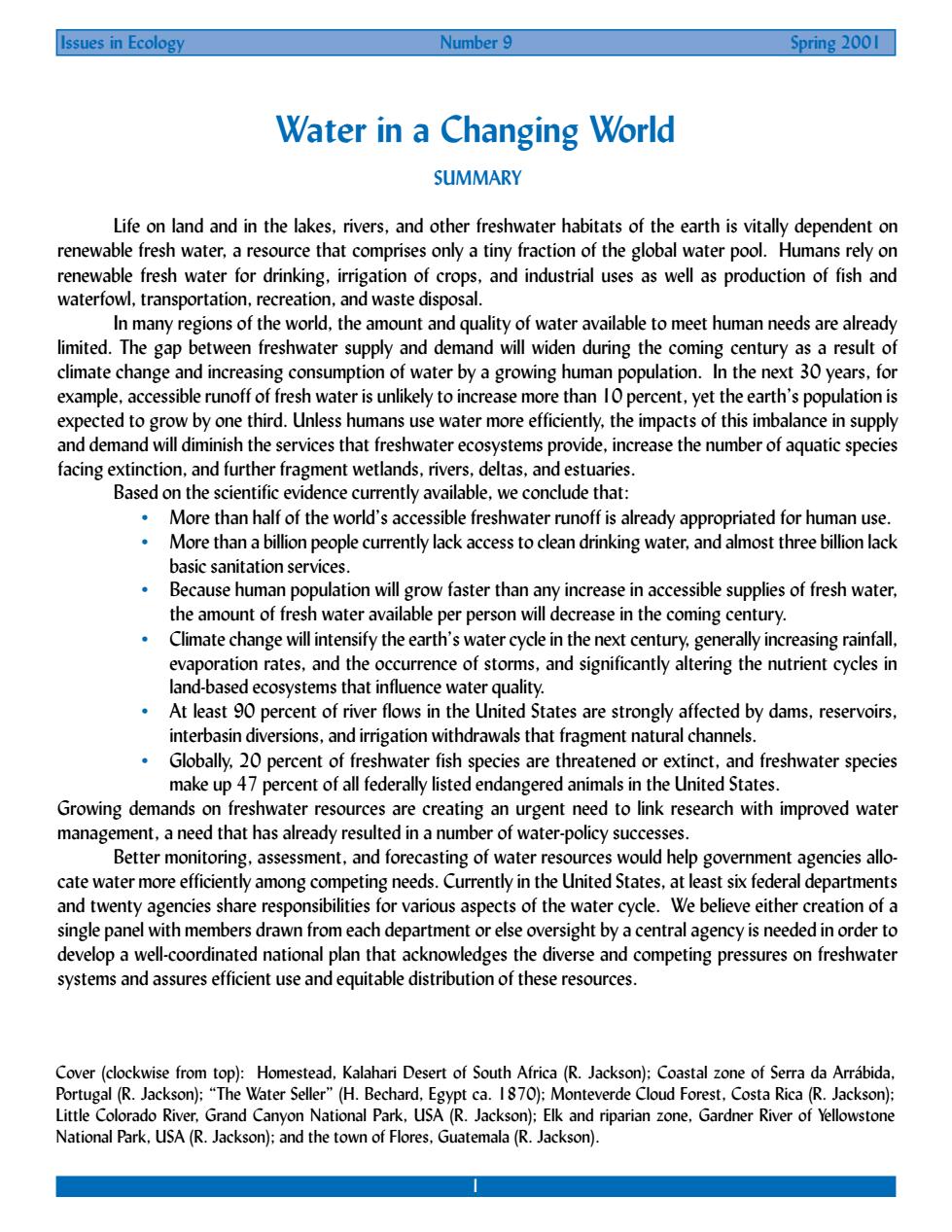正在加载图片...

Issues in Ecology Number 9 Spring 2001 Water in a Changing World SUMMARY Life on land and in the lakes,rivers,and other freshwater habitats of the earth is vitally dependenton renewable fresh water,a resource that comprises only a tiny fraction of the global water pool.Humans rely on terorking.indsuses as weasp waterfowl,transportation In many regions of the world,the amount and quality of water available to meet human needs are already limited.The gap between freshwater supply and demand will widen during the coming century as a result of climate change example,accessible runoff of fresh water is unlikely to increase more than 1 percent,yet the earth's population is expected to grow by one third.Unless humans use water more efficiently,the impacts of this imbalance in supply and demand will diminish the services that freshwater ecosystems provide,increase the number of aquatic species facing extinction,and further fragment wetlands,rivers,deltas,and estuaries. Based on the scientific evidence currently available,we conclude that: More than half of the world's accessible freshwater runoff is already appropriated for human use More than a billion people currently lack access to clean drinking water.and almost three billion lack basic sanitation services. Because human population will g ow faster than any increase in accessible supplies of fresh water the amount of fresh water available per person will decrease in the coming century. Climate change will intensify the earth's water cycle in the next century,generally increasing rainfall, urrence of storms.and significantly altering the nutrient cycles in At least 90 percent of river flows in the United States are strongly affected by dams,reservoirs. interbasin diversions,and irrigation withdrawals that fragment natural channels. Globally,20 percent of freshwater fish species are threatened or extinct,and freshwater species make up 47 percent of all federally listed endangered animals in the United States. of water-policy successes. Better monitoring.assessment,and forecasting of water resources would help government agencies allo cate water more efficiently among competing needs.Currently in the United States.at least six federal departments and twenty agencies share responsibilities for various aspects of the water ycle.We believe eithe creation of a single panel with members drawn from each department or else oversight by a central agency is needed in order to develop a well-coordinated national plan that acknowledges the diverse and competing pressures on freshwater systems and assures efficient use and equitable distribution of these resources. Cover(clockwise from top):Homestead,Kalahari Desert of South Africa (R.Jackson):Coastal zone of Serra da Arrabida The W ater (H.Be 1870 everde Cloud ica(R on USA (R. nd C ional Park.Sy and riparian zone.Gardner River of Yellowstone kson:吵and the town of Flores,Guatemala(R. Jackson) 1 Issues in Ecology Number 9 Spring 2001 SUMMARY Life on land and in the lakes, rivers, and other freshwater habitats of the earth is vitally dependent on renewable fresh water, a resource that comprises only a tiny fraction of the global water pool. Humans rely on renewable fresh water for drinking, irrigation of crops, and industrial uses as well as production of fish and waterfowl, transportation, recreation, and waste disposal. In many regions of the world, the amount and quality of water available to meet human needs are already limited. The gap between freshwater supply and demand will widen during the coming century as a result of climate change and increasing consumption of water by a growing human population. In the next 30 years, for example, accessible runoff of fresh water is unlikely to increase more than 10 percent, yet the earths population is expected to grow by one third. Unless humans use water more efficiently, the impacts of this imbalance in supply and demand will diminish the services that freshwater ecosystems provide, increase the number of aquatic species facing extinction, and further fragment wetlands, rivers, deltas, and estuaries. Based on the scientific evidence currently available, we conclude that: • More than half of the worlds accessible freshwater runoff is already appropriated for human use. • More than a billion people currently lack access to clean drinking water, and almost three billion lack basic sanitation services. • Because human population will grow faster than any increase in accessible supplies of fresh water, the amount of fresh water available per person will decrease in the coming century. • Climate change will intensify the earths water cycle in the next century, generally increasing rainfall, evaporation rates, and the occurrence of storms, and significantly altering the nutrient cycles in land-based ecosystems that influence water quality. • At least 90 percent of river flows in the United States are strongly affected by dams, reservoirs, interbasin diversions, and irrigation withdrawals that fragment natural channels. • Globally, 20 percent of freshwater fish species are threatened or extinct, and freshwater species make up 47 percent of all federally listed endangered animals in the United States. Growing demands on freshwater resources are creating an urgent need to link research with improved water management, a need that has already resulted in a number of water-policy successes. Better monitoring, assessment, and forecasting of water resources would help government agencies allocate water more efficiently among competing needs. Currently in the United States, at least six federal departments and twenty agencies share responsibilities for various aspects of the water cycle. We believe either creation of a single panel with members drawn from each department or else oversight by a central agency is needed in order to develop a well-coordinated national plan that acknowledges the diverse and competing pressures on freshwater systems and assures efficient use and equitable distribution of these resources. Water in a Changing World Cover (clockwise from top): Homestead, Kalahari Desert of South Africa (R. Jackson); Coastal zone of Serra da Arrábida, Portugal (R. Jackson); The Water Seller (H. Bechard, Egypt ca. 1870); Monteverde Cloud Forest, Costa Rica (R. Jackson); Little Colorado River, Grand Canyon National Park, USA (R. Jackson); Elk and riparian zone, Gardner River of Yellowstone National Park, USA (R. Jackson); and the town of Flores, Guatemala (R. Jackson).��